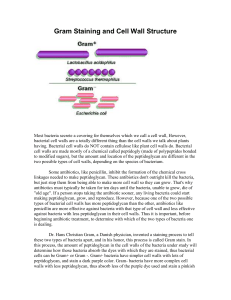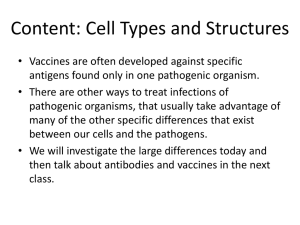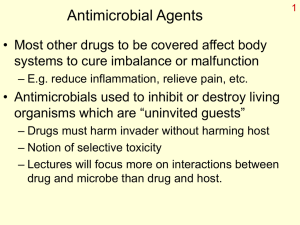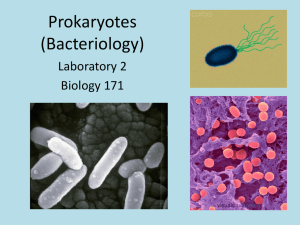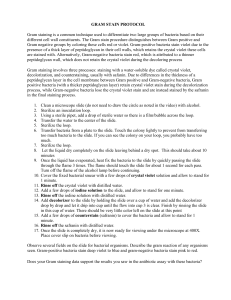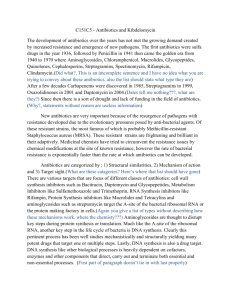Bacteria and Antibiotics
advertisement
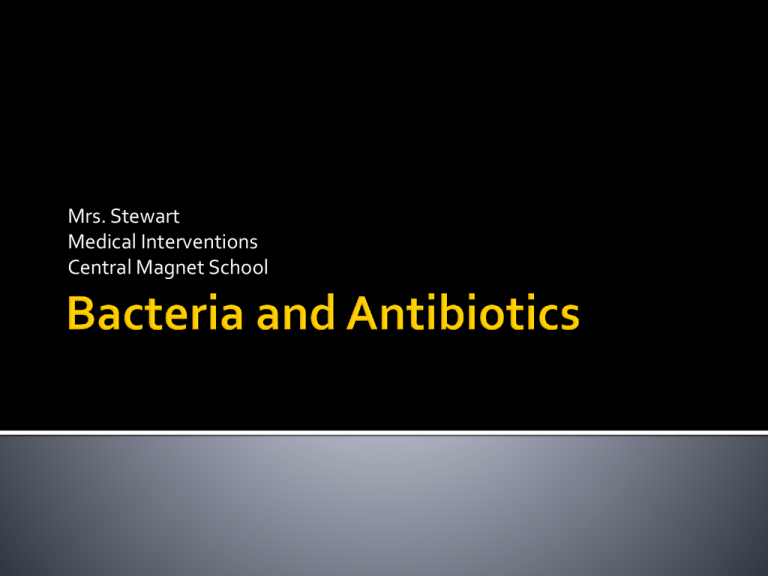
Mrs. Stewart Medical Interventions Central Magnet School GRAM (-) GRAM (+) Thin layer of peptidoglycan Thick layer of peptidoglycan Lipopolysaccharides (endotoxins) Stain blueish - purple Stain red Bacteria are stained with two stains: 1. Crystal Violet stain (blue/purple) 2. Fuchsin counterstain (red) Gram – Gram + Blueish-purple Red Peptidoglycan layer absorbs the crystal violet stain LPS cell wall prohibits peptidoglycan layer from absorbing crystal violet stain (absorbs counter stain) What cellular components do some bacterial cells have that make them powerful pathogens? Explain. GRAM - Antibiotics are drugs used to treat infections caused by bacteria. Antibiotic - A substance produced by or derived from a microorganism and able in dilute solution to inhibit or kill another microorganism History of Antibiotics •1928- Alexander Fleming •Accidentally discovered penicillin •Left lab untidy for a month and went on vacation •Came back and found a fungus growing in one of his bacterial cultures. Fungus was inhibiting the bacteria. •Fungus = penicillium notatum •Later named: penicillin Gangrene – wound infections that lead to many amputations or sepsis Sepsis – bacterial infection in blood stream – leads to organ system failures The early antibiotics = natural products of other microorganisms (fungi or other bacteria) Now = created synthetically (chemically altering existing natural products) Depends on the bacteria Gram + OR Gram Bactericidal – Kills the bacteria Bacteriostatic – inhibits growth & reproduction * The body’s natural defenses can usually take it from there Beta – Lactam Fluoroquinolones Tetracyclines Sulfanomides Disrupt the synthesis of peptidoglycan thereby inhibiting cell wall synthesis & damaging cell wall integrity Broad spectrum (can work against + or -) Bactericidal Example: Penicillins Why are penicillins often more effective against gram positive than gram negative bacteria? Inhibit topoisomerase enzymes which prohibit DNA replication and protein synthesis Broad spectrum – effective against + and - Bind the 30s ribosomal subunit, blocking the attachment of tRNA, thereby inhibiting protein synthesis Broad spectrum – effective against + and - 1st class of antibiotics ever used Structurally similar to PABA – a substance that the bacteria use to synthesize folate (folic acid) Inhibits the synthesis of folic acid (Folate) folate is necessary for DNA synthesis No DNA synthesis (replication) = No cell division Why is it important to understand the structure of a bacterial cell when developing an antibiotic? What class of antibiotics would you prescribe for Sue? Explain. Bacterial infections only Antibiotics target bacteria and a few parasites. They do not share the same structures Viruses consist of a hereditary material (DNA or RNA) surrounded by a protein coat or fatty envelope. They do not have any organelles – they hijack host cells to produce more DNA/RNA or proteins Antibiotics are not effective against viruses. Most colds and sore throats are caused by viruses How do antibiotics function without harming the surrounding human cells? NO That leads to antibiotic resistance due to overuse There are more bacterial cells in/on your body than there are human cells Antibiotics will target all susceptible bacteria – not just the spot of infection All bacteria living within your body will either die (susceptible) or will live (resistant) Survival of the fittest Ear Infections MRSA TB – Tuberculosis Strep throat



